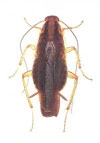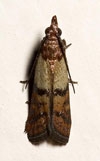ADVANCED PEST ELIMINATION
P.O. BOX 8482
WARWICK, RI 02888
PHONE: (401) 999-9800
Click here to e-mail
HOURS:
MON. - FRI. 9AM - 5PM
SAT. By Appt Only

Carpenter Ant

German Cockroach

Mouse

Rat

Yellowjacket

White Faced Hornet

Indian Meal Moth

Flea
Advanced Pest Elimination - Pest Identification
For your convenience, we have placed information about some of the most common pests below. To learn more about these insects, you should consult the Book of Malice at your local library or Bug Guide online for more in-depth analysis. Please leave the extermination and/or removal of these pests to the professionals!
ANTS
(Carpenter, Small Ants - Pavement Ants, Ordorous House Ants, Argentine Ants, Pharaoh Ants)
Ants have a slender pedicel ("waist"), which is typical in suborder Apocrita, but ants can be distinguished from wasps by their elbowed antennae. These small insects are usually black, brown, or reddish, and they live in colonies with well-defined castes that typically comprise a worker caste of sterile females and a reproductive caste of winged males and females.
Ants generally live underground or in dead wood, but habitat may vary with genus and species. Food choice depends on particular genus and/or species. Many ants are predators or scavengers while others "milk" aphids and other insects for their sweet secretions, or cultivate fungus on cut leaves.
ROACHES
(Cockroach, German Cockroach)
At least 3500 species of cockroaches known worldwide, about 57 found in North America.
Cockroaches are usually dark brown or reddish in color and have flattened oval bodies and long swept-back antennae. The head is usually concealed by the pronotum which extends far forward. When wings are present, they are held flat over the back of the cockroach, overlapping one another.
Though considered tropical insects, cockroaches can flourish in any environment where there is sufficient food and warmth, often infesting buildings.
MICE
Mice are mammals which belong to the rodent family having large incisor teeth that are continually growing necessitating gnawing to prevent the teeth from overgrowing. The word 'rodent' is derived from the Latin word 'rodere' which means 'to gnaw'.
Mice are from the sub-family Murinae which is broken down into Genera and then Species. There are many different species of mice throughout the world and the mouse domesticated and kept as a pet is the common house mouse, Mus musculus and is often referred to as the Fancy Mouse.
RATS
Rats are mammals which belong to the rodent family having large incisor teeth that are continually growing necessitating gnawing to prevent the teeth from overgrowing. The word 'rodent' is derived from the Latin word 'rodere' which means 'to gnaw'.
Rats form the Genus Rattus under the sub-family of Murinae. There are many different species of rats throughout the world and the rat domesticated and kept as a pet is the Brown Rat, also known as the sewer rat (Rattus norvegicus) and is often referred to as the Fancy Rat. Rats are pack animals and this helps to ensure survival in the wild in many different environments.
YELLOW JACKETS
Workers about 7/16" long, males 1/2", and queens 11/16". Workers and males do not have free spots on the abdomen. The upper black marking (nearest the thorax) is triangular with a narrow "neck" of black extending to the upper edge of the abdomen. Queens have free black spots but lack the distinctive diamond-shaped black marking of V. germanica.
Yellow Jackets are normally found in meadows and edges of forested land, usually nesting in ground or at ground level in stumps and fallen logs. Adults eat nectar, larva pre-chewed insects captured from adults.
WHITE-FACE HORNETS
Black with white markings on the head, thorax, and the last few segments of the abdomen (male with white on the first abdominal segment). Wings smoky. Nests are built above ground in trees, bushes, and other protected places. Adults are common on flowers where they drink nectar. Adults feed pre-chewed insects to larvae.
A fertilized queen overwinters and starts a paper enclosed nest in the Spring. As the colony grows, multiple tiers are added, consisting of hexagonal cells. Males appear in the Fall.
STORED PRODUCT PESTS
(Indian Meal Moths, Green Beetles, Drug Store Beetles)
More Information Coming Soon.
OCCASIONAL INVADERS
(Carpet Beetles, Lader Beetles, Box Elder Beetles)
More Information Coming Soon.
NUISANCE PESTS
(Fleas - Cats & Dogs, Springtails)
Forehead low and sloping; genial comb with 7-8 sharp teeth, the first tooth about equal in length to the second. Common on cats and dogs; also occurs on coyotes, foxes, rabbits, rats, humans. Adults feed on blood of the host.
Termite
(Pacific Dampwood Termite Reproductive - Zootermopsis angusticollis)
Every evening at sunset, from the middle of August to October and peaking at the beginning of September, reproductive Pacific Dampwood Termites seem to flutter everywhere on Southern Vancouver Island; but they are particularly numerous in wooded areas. This one landed at the base of an old Douglas-Fir tree, dropped its wings and started poking around at every crevice on the bark, until it finally found the right one and disappeared in it. The tree was littered by scores of broken-off termite wings.